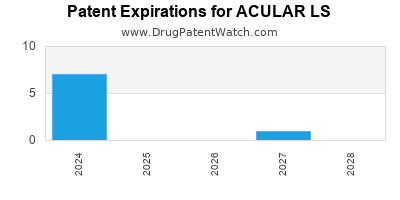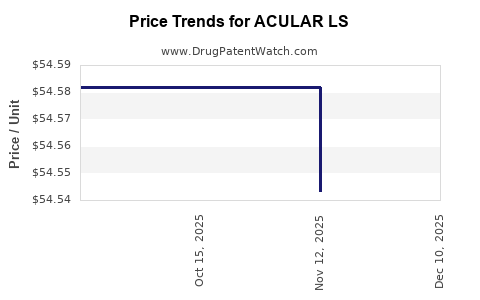ACULAR LS Drug Patent Profile
✉ Email this page to a colleague
When do Acular Ls patents expire, and what generic alternatives are available?
Acular Ls is a drug marketed by Abbvie and is included in one NDA. There is one patent protecting this drug and one Paragraph IV challenge.
This drug has five patent family members in three countries.
The generic ingredient in ACULAR LS is ketorolac tromethamine. There are eighteen drug master file entries for this compound. Sixty-four suppliers are listed for this compound. Additional details are available on the ketorolac tromethamine profile page.
DrugPatentWatch® Litigation and Generic Entry Outlook for Acular Ls
A generic version of ACULAR LS was approved as ketorolac tromethamine by MYLAN on May 16th, 1997.
AI Deep Research
Questions you can ask:
- What is the 5 year forecast for ACULAR LS?
- What are the global sales for ACULAR LS?
- What is Average Wholesale Price for ACULAR LS?
Summary for ACULAR LS
| International Patents: | 5 |
| US Patents: | 1 |
| Applicants: | 1 |
| NDAs: | 1 |
| Finished Product Suppliers / Packagers: | 3 |
| Raw Ingredient (Bulk) Api Vendors: | 89 |
| Clinical Trials: | 23 |
| Patent Applications: | 4,710 |
| Drug Prices: | Drug price information for ACULAR LS |
| Patent Litigation and PTAB cases: | See patent lawsuits and PTAB cases for ACULAR LS |
| What excipients (inactive ingredients) are in ACULAR LS? | ACULAR LS excipients list |
| DailyMed Link: | ACULAR LS at DailyMed |


Recent Clinical Trials for ACULAR LS
Identify potential brand extensions & 505(b)(2) entrants
| Sponsor | Phase |
|---|---|
| Emory University | Early Phase 1 |
| University of Louisville | Phase 4 |
| Arthroplasty Foundation, Inc. | Phase 4 |
Pharmacology for ACULAR LS
| Drug Class | Cyclooxygenase Inhibitor Nonsteroidal Anti-inflammatory Drug |
| Mechanism of Action | Cyclooxygenase Inhibitors |
Paragraph IV (Patent) Challenges for ACULAR LS
| Tradename | Dosage | Ingredient | Strength | NDA | ANDAs Submitted | Submissiondate |
|---|---|---|---|---|---|---|
| ACULAR LS | Ophthalmic Solution | ketorolac tromethamine | 0.4% | 021528 | 1 | 2005-01-28 |
US Patents and Regulatory Information for ACULAR LS
| Applicant | Tradename | Generic Name | Dosage | NDA | Approval Date | TE | Type | RLD | RS | Patent No. | Patent Expiration | Product | Substance | Delist Req. | Exclusivity Expiration |
|---|---|---|---|---|---|---|---|---|---|---|---|---|---|---|---|
| Abbvie | ACULAR LS | ketorolac tromethamine | SOLUTION/DROPS;OPHTHALMIC | 021528-001 | May 30, 2003 | AT | RX | Yes | Yes | 8,008,338*PED | ⤷ Get Started Free | Y | ⤷ Get Started Free | ||
| >Applicant | >Tradename | >Generic Name | >Dosage | >NDA | >Approval Date | >TE | >Type | >RLD | >RS | >Patent No. | >Patent Expiration | >Product | >Substance | >Delist Req. | >Exclusivity Expiration |
Expired US Patents for ACULAR LS
| Applicant | Tradename | Generic Name | Dosage | NDA | Approval Date | Patent No. | Patent Expiration |
|---|---|---|---|---|---|---|---|
| Abbvie | ACULAR LS | ketorolac tromethamine | SOLUTION/DROPS;OPHTHALMIC | 021528-001 | May 30, 2003 | 9,216,127 | ⤷ Get Started Free |
| Abbvie | ACULAR LS | ketorolac tromethamine | SOLUTION/DROPS;OPHTHALMIC | 021528-001 | May 30, 2003 | 5,110,493*PED | ⤷ Get Started Free |
| Abbvie | ACULAR LS | ketorolac tromethamine | SOLUTION/DROPS;OPHTHALMIC | 021528-001 | May 30, 2003 | 8,648,107 | ⤷ Get Started Free |
| Abbvie | ACULAR LS | ketorolac tromethamine | SOLUTION/DROPS;OPHTHALMIC | 021528-001 | May 30, 2003 | 8,541,463*PED | ⤷ Get Started Free |
| Abbvie | ACULAR LS | ketorolac tromethamine | SOLUTION/DROPS;OPHTHALMIC | 021528-001 | May 30, 2003 | 8,207,215*PED | ⤷ Get Started Free |
| Abbvie | ACULAR LS | ketorolac tromethamine | SOLUTION/DROPS;OPHTHALMIC | 021528-001 | May 30, 2003 | 9,216,167 | ⤷ Get Started Free |
| >Applicant | >Tradename | >Generic Name | >Dosage | >NDA | >Approval Date | >Patent No. | >Patent Expiration |
International Patents for ACULAR LS
See the table below for patents covering ACULAR LS around the world.
| Country | Patent Number | Title | Estimated Expiration |
|---|---|---|---|
| Japan | 2954642 | ⤷ Get Started Free | |
| World Intellectual Property Organization (WIPO) | 2016077726 | ⤷ Get Started Free | |
| Norway | 175404 | ⤷ Get Started Free | |
| European Patent Office | 3777808 | SYSTÈMES DE LIT (BED SYSTEMS) | ⤷ Get Started Free |
| South Korea | 184864 | ⤷ Get Started Free | |
| Australia | 5220190 | ⤷ Get Started Free | |
| >Country | >Patent Number | >Title | >Estimated Expiration |
Supplementary Protection Certificates for ACULAR LS
| Patent Number | Supplementary Protection Certificate | SPC Country | SPC Expiration | SPC Description |
|---|---|---|---|---|
| 1534313 | 15C0090 | France | ⤷ Get Started Free | PRODUCT NAME: SOLUTION D'IRRIGATION OCULAIRE COMPRENANT DE LA PHENYLEPHRINE OU UN SEL PHARMACEUTIQUEMENT ACCEPTABLE DE CELLE-CI ET DU KETOROLAC OU UN SEL PHARMACEUTIQUEMENT ACCEPTABLE DE CELUI-CI; REGISTRATION NO/DATE: EU/1/15/1018 20150728 |
| 1534313 | 122015000111 | Germany | ⤷ Get Started Free | PRODUCT NAME: PHENYLEPHRIN UND KETOROLAC; REGISTRATION NO/DATE: EU/1/15/1018 20150728 |
| 1534313 | 2015/071 | Ireland | ⤷ Get Started Free | PRODUCT NAME: AN OCULAR IRRIGATION SOLUTION COMPRISING PHENYLEPHRINE OR A PHARMACEUTICALLY ACCEPTABLE SALT THEREOF AND KETOROLAC OR A PHARMACEUTICALLY ACCEPTABLE SALT THEREOF; REGISTRATION NO/DATE: EU/1/15/1018 20150728 |
| 1534313 | 300784 | Netherlands | ⤷ Get Started Free | PRODUCT NAME: KETOROLAC, OF HET TROMETAMOLZOUT ERVAN, EN FENYLEFRINE, OF HET HYDROCHLORIDEZOUT ERVAN; REGISTRATION NO/DATE: EU/1/15/1018 20150730 |
| 1534313 | 76/2015 | Austria | ⤷ Get Started Free | PRODUCT NAME: PHENYLEPHRIN, ODER EIN PHARMAZEUTISCH ANNEHMBARES SALZ DAVON, UND KETOROLAC, ODER EIN PHARMAZEUTISCH ANNEHMBARES SALZ DAVON; REGISTRATION NO/DATE: EU/1/15/1018 (MITTEILUNG) 20150730 |
| 1534313 | 92923 | Luxembourg | ⤷ Get Started Free | PRODUCT NAME: UNE SOLUTION D'IRRIGATION OCULAIRE COMPRENANT DE LA PHENYLEPHRINE OU UN SEL PHARMACEUTIQUEMENT ACCEPTABLE DE CELLE-CI ET DU KETOROLAC OU UN SEL PHARMACEUTIQUEMENT ACCEPTABLE DE CELUI-CI; FIRST REGISTRATION: 20150730 |
| >Patent Number | >Supplementary Protection Certificate | >SPC Country | >SPC Expiration | >SPC Description |
Market Dynamics and Financial Trajectory for ACULAR LS
More… ↓
Make Better Decisions: Try a trial or see plans & pricing
Drugs may be covered by multiple patents or regulatory protections. All trademarks and applicant names are the property of their respective owners or licensors. Although great care is taken in the proper and correct provision of this service, thinkBiotech LLC does not accept any responsibility for possible consequences of errors or omissions in the provided data. The data presented herein is for information purposes only. There is no warranty that the data contained herein is error free. We do not provide individual investment advice. This service is not registered with any financial regulatory agency. The information we publish is educational only and based on our opinions plus our models. By using DrugPatentWatch you acknowledge that we do not provide personalized recommendations or advice. thinkBiotech performs no independent verification of facts as provided by public sources nor are attempts made to provide legal or investing advice. Any reliance on data provided herein is done solely at the discretion of the user. Users of this service are advised to seek professional advice and independent confirmation before considering acting on any of the provided information. thinkBiotech LLC reserves the right to amend, extend or withdraw any part or all of the offered service without notice.
